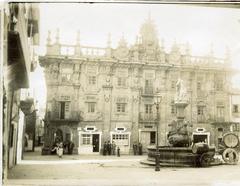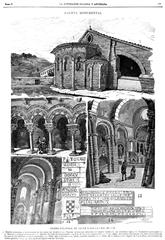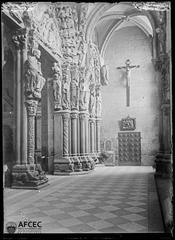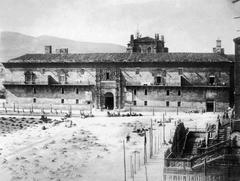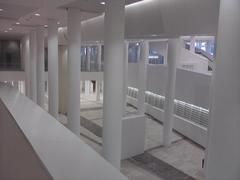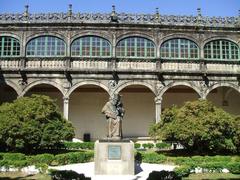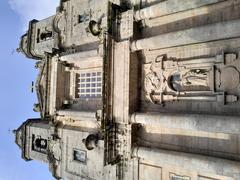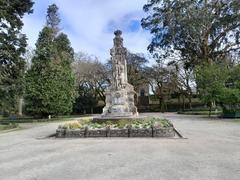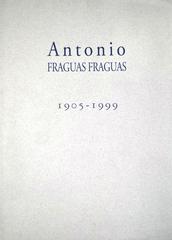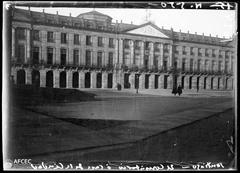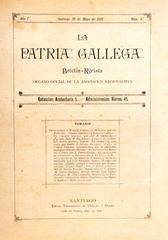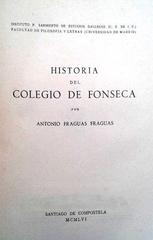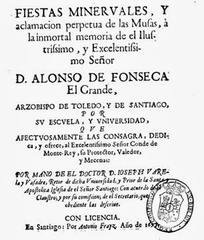Santiago De Compostela Railway Station Visiting Hours Tickets and Travel Guide
Date: 14/06/2025
Introduction to Santiago De Compostela Railway Station and Its Importance
Santiago de Compostela Railway Station serves as a pivotal gateway to one of Spain’s most revered cultural and spiritual destinations. Situated in the heart of Galicia, this transport hub not only facilitates seamless connectivity for travelers and pilgrims arriving via the famed Camino de Santiago but also embodies a rich historical and architectural legacy that reflects the city’s evolving urban fabric. Established in the mid-20th century as part of the Atlantic axis rail corridor, the station has witnessed significant transformations that balance modern mobility needs with heritage preservation and ecological awareness. Today, it stands as an innovative intermodal complex featuring contemporary design elements such as prefabricated concrete structures, translucent materials, and thoughtfully integrated public spaces like the Plaza de Clara Campoamor, enhancing both passenger experience and urban cohesion.
Beyond its functional role, the station is intrinsically linked to Santiago’s identity as a UNESCO World Heritage site and a major pilgrimage terminus, welcoming thousands of visitors annually. Its convenient proximity to the historic center and key landmarks like the Cathedral of Santiago de Compostela underscores its importance as a cultural threshold. Moreover, the station champions sustainable travel by promoting rail as an eco-friendly alternative to air and car transport, facilitating regional exploration, and supporting local initiatives aimed at responsible tourism.
For travelers, understanding the station’s visiting hours, ticketing options—including special pilgrimage fares—accessibility features, and available amenities is essential for a smooth journey. Additionally, the station’s integration with local buses, taxis, and bicycle facilities ensures easy access to iconic attractions and natural sites such as Las Brañas del Sar. This comprehensive guide aims to provide detailed insights into the station’s history, architecture, cultural significance, and practical visitor information, empowering you to make the most of your visit to Santiago de Compostela. (ArchDaily, Renfe Official Website, International Traveller, walkthecamino.com)
Table of Contents
- Introduction
- Historical Evolution of Santiago de Compostela Railway Station
- Architectural Features and Materials
- Cultural and Urban Significance
- Practical Visitor Information
- Architectural Highlights to Observe
- Frequently Asked Questions (FAQ)
- Conclusion
Introduction
Santiago de Compostela Railway Station stands as a vital gateway to one of Spain’s most historically rich and culturally significant cities. Known for its role in connecting pilgrims and travelers to the famed Camino de Santiago, the station combines a fascinating historical evolution with innovative architectural design. This article explores the station’s past, its architectural transformation, practical visitor information including visiting hours and ticketing, and nearby attractions to help you plan a memorable visit.
Historical Evolution of Santiago de Compostela Railway Station
Early Development and Urban Impact
The origins of the Santiago de Compostela Railway Station date back to the mid-20th century, a period marked by significant infrastructural expansion across Spain. The station was strategically established along the Atlantic axis, a vital rail corridor traversing Galicia from north to south. Its construction required the creation of a broad esplanade for the railway yard, resulting in a pronounced embankment that extended toward the city and necessitated substantial landfills on the lowlands of the River Sar (Divisare). This intervention not only facilitated rail connectivity but also imposed a physical barrier, effectively limiting Santiago’s urban growth to the south for decades.
Despite this, the railway’s presence inadvertently preserved the natural area of Las Brañas del Sar, a zone of considerable ecological value that remains relatively undiscovered by locals and visitors alike (ArchDaily). The railway’s alignment thus played a dual role: fostering modern mobility while shaping the city’s spatial and environmental legacy.
Architectural Transformation and Intermodality
The original station building was designed in the typical style of mid-century Spanish railway architecture, with the passenger terminal positioned parallel to the tracks and protected by a metal canopy (Divisare). Over time, the station evolved to accommodate the growing demands of both local commuters and international pilgrims arriving via the Camino de Santiago.
A major milestone in the station’s history is its ongoing transformation into the Santiago de Compostela Intermodal Complex. This ambitious redevelopment project, led by Estudio Herreros, envisions a new high-speed train station constructed above the existing railways. The design integrates a pedestrian walkway along the west side, creating a seamless urban connection between the historic center and the southern neighborhoods previously divided by the tracks (ArchDaily).
The new station’s layout features a spacious lobby with direct visual and functional access to the platforms, facilitated by a system of “fingers” equipped with escalators, stairways, and high-capacity elevators. This arrangement not only enhances passenger flow but also embodies a contemporary approach to intermodality, linking train, bus, taxi, and urban bus services within a single transport hub (ArchDaily).
Architectural Features and Materials
Structural Innovation
The architectural language of the new station is defined by its pragmatic use of modern materials and construction techniques. Prefabricated concrete columns support a deck upon which the main building is raised, utilizing lightweight, translucent, and dry-mounted systems. The station’s exterior is characterized by zinc decks, golden stretch metal enclosures, polycarbonate, and U-glass, all unified by green-colored metal structures (ArchDaily). This palette not only ensures durability and ease of maintenance but also imparts a distinctive visual identity to the transport hub.
Integration with Public Space
A key architectural gesture is the creation of the pedestrian footbridge, which spans the platforms and connects the passenger building to the broader urban fabric. At the southern end, the new Plaza de Clara Campoamor unfolds as a generous public space, conceived as a democratic counterweight to the forthcoming Plaza de la Estación on the north side (ArchDaily). These plazas are designed to foster social interaction and civic engagement, reinforcing the station’s role as both a mobility node and a community landmark.
Visual and Functional Connectivity
The station’s design prioritizes transparency and accessibility. Large glazed surfaces and open sightlines ensure that passengers can easily orient themselves within the complex, while the integration of escalators and elevators guarantees barrier-free movement for travelers of all ages and abilities. The architectural emphasis on light and openness reflects contemporary trends in European transport infrastructure, where stations are conceived as welcoming gateways rather than mere transit points (ArchDaily).
Cultural and Urban Significance
Gateway to Pilgrimage and Heritage
Santiago de Compostela is globally renowned as the terminus of the Camino de Santiago, a UNESCO World Heritage pilgrimage route that has shaped the city’s identity for over a millennium (International Traveller). The railway station serves as a modern-day gateway for thousands of pilgrims and tourists who arrive each year, many of whom continue their journey on foot to the iconic Cathedral of Santiago de Compostela. The station’s proximity to the historic center and its integration with other transport modes make it a vital entry point for experiencing the city’s spiritual and architectural treasures.
Reconnecting Divided Communities
For much of its history, the railway infrastructure acted as a formidable barrier between the historic core and the southern districts of Santiago. The current redevelopment aims to heal this urban rift by providing new pedestrian connections and public spaces that encourage movement and interaction across previously segregated areas (ArchDaily). This reconnection is not only physical but also symbolic, reflecting broader efforts to balance heritage preservation with contemporary urban needs.
Ecological Considerations
The preservation of Las Brañas del Sar, a natural area adjacent to the railway corridor, underscores the station’s ecological significance. By limiting urban encroachment, the railway has inadvertently safeguarded a valuable green space that contributes to Santiago’s environmental sustainability and offers opportunities for future recreational and educational initiatives (ArchDaily).
Practical Visitor Information
Visiting Hours
The Santiago de Compostela Railway Station is generally open daily from 5:00 AM to 11:00 PM, accommodating early morning and late evening train services. However, it is advisable to check the official Renfe website or station notice boards for any changes during holidays or special events.
Ticketing Information
Tickets for trains departing from Santiago de Compostela can be purchased online via the official Renfe website, through mobile apps, at ticket counters inside the station, or at automated kiosks. Prices vary depending on the destination, class of service, and time of booking. Discounted fares are often available for seniors, youth, and groups. For pilgrims, special pilgrimage tickets may be offered during peak seasons.
Accessibility
The station is fully accessible for people with disabilities, featuring ramps, elevators, tactile paving, and adapted restrooms. Staff assistance is also available upon request to help with boarding or navigating the station.
Special Events and Guided Tours
Occasionally, the station hosts cultural events or exhibitions related to the city’s heritage and the Camino de Santiago. Guided tours focusing on the station’s architecture and history can sometimes be arranged through local tourist offices or cultural associations. Visitors interested in such experiences should inquire locally or check event calendars.
Nearby Attractions and Travel Tips
- Cathedral of Santiago de Compostela: Just a 15-minute walk from the station, this iconic cathedral is the final destination for pilgrims on the Camino.
- Historic Old Town: Explore the UNESCO World Heritage-listed old town with its charming plazas, museums, and eateries.
- Las Brañas del Sar: A natural green space near the station, perfect for a peaceful walk or nature observation.
Travelers are encouraged to use the intermodal connections at the station, including urban buses and taxis, to conveniently reach these attractions.
Architectural Highlights to Observe
Visitors should take time to appreciate the station’s architectural details, including the interplay of materials, the innovative use of natural light, and the integration of public art and landscaping in the surrounding plazas. The pedestrian walkway offers unique vantage points for viewing the platforms and the city beyond, while the Plaza de Clara Campoamor provides inviting spaces for rest and reflection.
Frequently Asked Questions (FAQ)
Q: What are the Santiago de Compostela Railway Station’s opening hours? A: The station generally operates from 5:00 AM to 11:00 PM daily, but it’s best to check official sources for any variations.
Q: How can I buy tickets for trains at the station? A: Tickets can be purchased online through Renfe’s website or app, at ticket counters, or via automated kiosks inside the station.
Q: Is the station fully accessible for disabled visitors? A: Yes, the station features ramps, elevators, tactile paving, and adapted facilities to ensure accessibility.
Q: Are guided tours available at the station? A: Guided tours may be available occasionally; check with local tourist offices or the station’s event schedule.
Q: What nearby attractions can I visit from the station? A: The Cathedral of Santiago de Compostela, the historic old town, and Las Brañas del Sar natural area are all nearby and easily accessible.
Conclusion
Santiago de Compostela Railway Station is more than a transit point; it is a historic and architectural landmark that embodies the city’s rich cultural heritage and commitment to modern connectivity. Whether you are a pilgrim arriving on the Camino de Santiago or a traveler eager to explore Galicia, the station offers practical amenities, stunning design, and seamless access to the city’s treasures.
Plan your visit by checking the latest ticketing and schedule information, take time to admire the station’s architectural features, and explore the nearby historical sites that make Santiago de Compostela a truly unique destination.
For more travel tips and updates, don’t forget to download the Audiala app, explore related articles on Santiago’s heritage, and follow us on social media to stay inspired for your next adventure!
Images and media suggestions:
- Photo of the station exterior with the caption “Santiago de Compostela Railway Station exterior”
- Interior view highlighting the spacious lobby and platforms “Interior of Santiago de Compostela Station”
- Map showing the station’s location relative to the city center and nearby attractions
Internal links suggestions:
- Camino de Santiago pilgrimage routes
- Historical sites in Santiago de Compostela
Official resources:
Introduction
Santiago De Compostela Railway Station is a vital transport hub connecting the historic city of Santiago de Compostela with major Spanish cities and regional destinations. Perfectly positioned just 2 km from the city center, the station serves as a gateway for pilgrims completing the Camino de Santiago, tourists exploring Galicia’s rich cultural heritage, and business travelers alike. This comprehensive guide covers essential information including visiting hours, ticketing options, accessibility, and nearby attractions to ensure a seamless travel experience.
Modern Role of Santiago De Compostela Railway Station
Strategic Transport Hub in Galicia
Santiago De Compostela Railway Station plays a crucial role in Galicia’s transportation network. Located only a short distance from the city’s historic core, it connects travelers to major Spanish cities such as Madrid, Barcelona, Bilbao, and Valencia, as well as regional centers like A Coruña and Vigo. The station supports a range of services including AVE (Alta Velocidad Española) and Alvia high-speed trains, which have reduced travel times significantly — for example, Madrid is now reachable in approximately 3.5 hours, and A Coruña in under 30 minutes (Renfe Official Site). This connectivity enhances Santiago’s standing as a cultural and economic hub in the region.
Architectural Features and Passenger Experience
Combining contemporary design with traditional Galician aesthetics, the station offers a welcoming environment. Features include a spacious, well-lit concourse with clear signage in Spanish and English. Accessibility is prioritized with elevators, ramps, and tactile paving. Amenities to enhance traveler comfort include:
- Shops and Retail Outlets: Convenient stores and souvenir shops for essentials and gifts.
- Cafés and Restaurants: Diverse dining options catering to various tastes.
- Luggage Storage: Secure facilities allowing visitors to explore the city luggage-free.
- Restrooms and Waiting Areas: Clean, comfortable spaces for rest.
- Parking: Paid parking adjacent to the station with short- and long-term options.
Visiting Hours and Ticket Information
The station operates daily with ticket counters available from early morning until late evening. Automated machines provide 24/7 access to ticket purchasing. Travelers can also book tickets online or via mobile apps such as Omio and the Renfe app, which offer real-time schedules, mobile ticketing, and live updates.
It is advisable to arrive at least 30 minutes before departure, especially during peak times or when boarding high-speed services. Security and ticket checks are conducted prior to boarding for a smooth and safe journey.
Accessibility and Safety
The station is designed for inclusivity with step-free access throughout. Passengers requiring assistance should contact station staff in advance or upon arrival. The facility is staffed throughout the day, with security personnel and CCTV ensuring safety. Well-lit platforms and regular patrols make early morning and late evening travel secure.
Connectivity and Local Transport Links
Santiago De Compostela Railway Station is approximately a 20-minute walk from the historic city center, making it convenient for visitors. Multiple city bus lines stop directly outside the station, providing access to key sites such as the Cathedral of Santiago de Compostela and Alameda Park. Taxis and ride-hailing services are readily available. For eco-friendly travel, bicycle racks are provided, promoting sustainable transport.
Nearby Attractions and Cultural Significance
The station is within walking distance of some of Galicia’s most iconic historical sites. The world-famous Cathedral of Santiago de Compostela, the final destination of the Camino pilgrimage, is less than 2 km away. Visitors can also enjoy Alameda Park’s panoramic views of the old city. These nearby attractions make the station not only a transport hub but a cultural gateway to Galicia’s rich heritage.
Practical Visitor Tips
- Arriving and Departing: Arrive at least 30 minutes before departure.
- Tickets: Book in advance via official sites like Renfe or trusted apps like Omio for best prices.
- Luggage: Use storage facilities if you plan to explore before check-in.
- Dining: Sample Galician specialties in station cafés or nearby eateries.
- Safety: Keep an eye on belongings; the station is safe but remain vigilant.
- Accessibility: Request assistance ahead of time if needed.
Digital Services and Travel Apps
Digital tools greatly enhance the travel experience. Free Wi-Fi is available throughout the station, and apps like Omio and Renfe provide journey planning, ticket purchasing, and live updates. These services ensure travelers stay informed and connected.
Environmental Initiatives
Santiago De Compostela Railway Station supports sustainable travel through bicycle facilities, prominently placed recycling bins, and the use of energy-efficient lighting, aligning with European environmental standards.
Frequently Asked Questions (FAQ)
Q1: What are the station’s opening hours? The station is open daily with ticket counters operating from early morning until late evening. Ticket machines are available 24/7.
Q2: How can I buy tickets? Tickets can be purchased at the station, online via the Renfe website or app, and through third-party apps like Omio.
Q3: Is the station accessible for passengers with reduced mobility? Yes, the station offers step-free access, elevators, ramps, and staff assistance upon request.
Q4: What are the visiting hours for the Cathedral of Santiago de Compostela? The Cathedral is generally open from early morning until evening, but hours can vary seasonally. Check the official Cathedral website for current details.
Q5: Are there luggage storage facilities at the station? Yes, secure luggage storage is available for a fee.
Conclusion
Santiago De Compostela Railway Station is more than just a transit point; it is a modern, accessible gateway to Galicia’s cultural and historical treasures. Whether you are a pilgrim, tourist, or business traveler, understanding the station’s facilities, ticketing options, and connectivity will enhance your visit. Plan ahead using official resources and apps to ensure a smooth and enjoyable journey.
Call to Action
For seamless travel planning and updates, download the Audiala app today. Explore related posts on Galicia’s historic sites and follow us on social media for the latest travel tips and news.
Image Suggestions:
- Exterior view of Santiago De Compostela Railway Station (alt: “Santiago De Compostela Railway Station exterior”)
- Interior concourse with passengers (alt: “Inside Santiago De Compostela Railway Station”)
- Nearby Cathedral of Santiago de Compostela (alt: “Cathedral of Santiago de Compostela”)
Internal Links:
- Link to articles on Galicia historical sites
- Link to guides on the Camino de Santiago pilgrimage
External Links:
Welcome to Santiago de Compostela: Your Complete Travel Guide
Santiago de Compostela, the historic capital of Galicia, is renowned worldwide for its stunning Cathedral and as the final destination of the legendary Camino de Santiago pilgrimage route. This guide offers essential information on visiting hours, ticketing, transport connections, and accessibility to help you make the most of your visit to this cultural gem.
Visiting Hours and Tickets for Santiago de Compostela’s Historical Sites
The Cathedral of Santiago de Compostela
- Visiting Hours: The Cathedral is typically open to visitors from 7:00 AM to 8:00 PM daily, with slight variations during holidays or special events. It’s advisable to check the official Cathedral website before your visit for up-to-date hours.
- Tickets: Entry to the Cathedral is free for pilgrims attending the Pilgrim’s Mass. For general visitors, tickets for guided tours or access to the Cathedral Museum can be purchased online or at the ticket office, with prices ranging from €5 to €10.
- Special Events: The Cathedral hosts religious ceremonies, concerts, and the famous Botafumeiro incense ritual. These events often require advance booking.
Other Galicia Historical Sites Nearby
- Monastery of San Martín Pinario: Open 10:00 AM – 7:30 PM, tickets around €6.
- Museo do Pobo Galego (Museum of the Galician People): Open 10:00 AM – 8:00 PM, tickets €4.
Rail Connections and Onward Travel Options
National and Regional Train Services
Santiago de Compostela Railway Station is a major transport hub in Galicia, serving as a gateway for both regional and long-distance rail travel. The station, located at Calle Hórreo 75 A, 15702 Santiago de Compostela, has been remodeled since its original inauguration in 1873 to accommodate modern services and increased passenger flow (The Trainline).
Long-Distance Trains:
- Madrid: There are seven daily direct trains between Santiago de Compostela and Madrid, with the fastest journey taking approximately 5 hours and 5 minutes. This high-frequency service makes it convenient for travelers heading to Spain’s capital (The Trainline).
- Barcelona: Trains to Barcelona, passing through Madrid, take under 9 hours, providing a direct link to the northeast of Spain.
- Porto (Portugal): Three daily services connect Santiago with Porto, Portugal, with a journey time of about 3 hours and 40 minutes.
Regional and Medium-Distance Trains:
- A Coruña: Avant high-speed trains operated by Renfe run 26 times daily between A Coruña and Santiago, with a journey time of just 28 minutes.
- Vigo: The same Avant service continues to Vigo, offering frequent and rapid connections along the Galician coast.
- Ourense and Puebla de Sanabria: Additional regional routes connect Santiago with Ourense and Puebla de Sanabria, facilitating access to inland Galicia and beyond.
Ticketing and Station Facilities:
The ticket office at Santiago de Compostela station maintains regular hours, and tickets can be purchased in advance online or at the station (The Trainline). For those with luggage or mobility needs, the C2 city bus provides a direct link between the station and the historical center.
Bus and Coach Connections
Intermodal Bus Station:
Santiago’s main bus terminal, known as the Intermodal station, is fully integrated with the railway station, allowing seamless transfers between train and bus services (Motion4Rent). The Intermodal station serves urban, regional, and long-distance routes, including connections to other Galician cities, Spanish regions, and international destinations.
Key Features:
- Accessibility: The Intermodal station is equipped with Braille information, elevators with speakers, ramps, and accessible restrooms, ensuring ease of use for travelers with disabilities.
- Urban Buses: Local buses connect the station with various neighborhoods and key points in the city, including the historic center and major hotels.
- Long-Distance Coaches: Companies such as Monbus operate services to Madrid, other Spanish cities, and even international destinations (Camino de Santiago Forum).
Airport Transfers
Santiago de Compostela Airport (SCQ):
The city’s airport is located approximately 13 km from the railway station.
- Airport Bus: A dedicated airport bus service links the Intermodal station and the airport, with frequent departures throughout the day. The journey typically takes 20–30 minutes.
- Taxi: Taxis are readily available at the station, and adapted vehicles for passengers with disabilities can be booked through the Eurotaxi company or by calling Radio Taxi at (+34) 981 569 292 (Motion4Rent).
Taxi and Private Transfers
Taxis are available 24 hours a day at the station. For travelers requiring accessible vehicles, Eurotaxi provides adapted taxis equipped for wheelchair users. Advance booking is recommended, especially during peak pilgrimage seasons.
Accessibility Features in Santiago de Compostela
Station and Intermodal Terminal Accessibility
Santiago de Compostela Railway Station and the Intermodal bus and train station complex are fully accessible for travelers with reduced mobility or disabilities (Motion4Rent). Facilities include:
- Barrier-free entrances and exits
- Adapted toilets and reserved parking spaces near entrances
- Elevators and ramps
- Braille and audio information panels
- Specialized assistance services through Renfe’s Atendo program
City Accessibility
The city has made significant efforts to improve accessibility, including:
- Accessible entrances to major attractions such as the Cathedral and Mercado de Abastos
- An accessibility guide available at the tourist office
- Wheelchair rental and accessible excursion services (Motion4Rent)
Top Tourist Attractions and Photographic Spots
- Cathedral of Santiago de Compostela: Marvel at its Romanesque façade and the Botafumeiro ceremony inside.
- Plaza del Obradoiro: The grand square offers iconic views of the Cathedral and is a perfect photo spot.
- Parque de la Alameda: Provides panoramic views of the old town and the Cathedral.
- Mercado de Abastos: A vibrant market ideal for tasting local Galician produce and capturing lively scenes.
Visitor Tips for a Smooth Trip
- Advance Planning: Book tickets and accommodation early, especially during spring and summer pilgrimage seasons.
- Luggage: Use the C2 bus or taxis for easy access if carrying heavy luggage.
- Guided Tours: Consider booking guided tours for deeper insights into the city’s history and hidden gems.
- Local Cuisine: Try traditional Galician dishes such as pulpo a la gallega and empanada in local eateries.
Frequently Asked Questions (FAQs)
Q: What are the Santiago de Compostela visiting hours for the Cathedral?
A: Generally, 7:00 AM to 8:00 PM daily, with possible variations during holidays. Check official sources for updates.
Q: Where can I buy Santiago de Compostela tickets?
A: Tickets can be purchased online via official websites or at ticket offices near the Cathedral and train station.
Q: How accessible is Santiago de Compostela for travelers with disabilities?
A: The city and its transport hubs offer extensive accessibility features, including adapted transport, accessible restrooms, and assistance services.
Q: What is the best way to get from Santiago airport to the city center?
A: The airport bus connects the airport with the Intermodal station and city center; taxis and adapted vehicles are also available.
Q: Are there guided tours available in Santiago de Compostela?
A: Yes, guided tours covering major historical sites and the Camino de Santiago are widely available and recommended.
Practical Information
- Passenger Volume: Santiago de Compostela Railway Station is the busiest in Galicia, with over 2.5 million passengers recorded in 2018 (Motion4Rent).
- Facilities: The station includes a cafeteria, ATMs, and waiting areas, all accessible to travelers with disabilities.
- Integration: The station’s integration with the Intermodal bus terminal and proximity to the airport make it a strategic point for onward travel throughout Spain and Portugal.
For the latest schedules, ticketing options, and accessibility details, please consult the official Renfe and The Trainline websites. For accessibility services and local support, refer to Motion4Rent.
Ready to explore Santiago de Compostela? Download the Audiala app for guided audio tours, or follow us on social media for the latest travel tips and updates!
Introduction
The Santiago de Compostela Railway Station is a vital gateway not only for transportation but also for cultural immersion and sustainable travel in Galicia, Spain. Whether you’re a pilgrim completing the legendary Camino de Santiago or a traveler eager to explore Santiago’s rich heritage, understanding the station’s visiting hours, ticketing options, and its cultural and environmental significance will enhance your journey.
Santiago de Compostela Railway Station Visiting Hours and Ticket Information
Visiting Hours
The Santiago de Compostela Railway Station is open daily from 5:30 AM to 11:30 PM, providing ample time for travelers to arrive and depart conveniently. The ticket offices operate from 6:00 AM to 10:00 PM, while self-service ticket machines are available 24/7 for added flexibility.
Ticket Options and How to Purchase
Tickets for trains arriving at or departing from Santiago de Compostela can be purchased online via official railway websites such as Renfe, at the station’s ticket counters, or through mobile apps. Early booking is recommended to secure the best fares and availability.
Types of tickets include:
- Standard and high-speed train tickets connecting Santiago with major cities like Madrid, Barcelona, and A Coruña.
- Regional train tickets for exploring nearby towns within Galicia.
For pilgrims, special discounts and luggage storage services are often available to accommodate their unique travel needs.
Cultural Significance of Santiago de Compostela Railway Station
The Station as a Gateway to Pilgrimage and Heritage
More than just a transit point, the Santiago de Compostela Railway Station serves as the cultural threshold to one of the world’s most renowned pilgrimage destinations. Situated about 1.5 km from the historic city center, it welcomes thousands of pilgrims completing the Camino de Santiago, a tradition dating back to the 9th century (walkthecamino.com).
The station’s architecture, inspired by traditional Galician manor houses (pazos), with its distinctive asymmetrical towers and portico arches, pays homage to the monumental character of Santiago’s Old Town (ilovecompostela.com; wikipedia). This blend of tradition and modernity makes the station a cultural landmark itself.
Integration with the City’s Cultural Fabric
Located conveniently close to Santiago’s UNESCO-listed Old Town, the Cathedral of Santiago de Compostela, the Monastery of San Martiño Pinario, and the Museum of the Galician People, the station is a gateway to the city’s rich cultural offerings (trek.zone). Its role extends beyond transportation, fostering cultural exchange as it welcomes visitors from across Spain and Europe.
The station is particularly vibrant during the annual Feast of Saint James on July 25th, when thousands of pilgrims and tourists converge, highlighting its importance in the city’s religious and cultural calendar (nomads-travel-guide.com).
The Station’s Role in Contemporary Pilgrimage
With over 4.3 million passengers recorded in 2024, Santiago de Compostela Railway Station is Galicia’s busiest station (wikipedia). Many pilgrims begin or conclude their spiritual journey here, benefiting from amenities like luggage storage, accessible ticket counters, and connectivity to local transport (spainrail.com).
Sustainable Travel Practices at Santiago de Compostela Railway Station
Promoting Low-Impact Mobility
Rail travel is one of the most sustainable long-distance transportation methods, producing significantly lower carbon emissions per passenger than air or car travel (followthecamino.com). The station connects Santiago with major urban centers such as Madrid, Barcelona, and A Coruña, providing eco-friendly alternatives to flying (spainrail.com).
Encouraging Responsible Tourism
Situated centrally, the station encourages visitors to explore Santiago de Compostela on foot, minimizing carbon footprints while allowing deeper engagement with Santiago’s historical sites, local cuisine, and culture (spainrail.com). Local initiatives promote sustainable behaviors such as:
- Using public transport options including buses and regional trains (packing-up-the-pieces.com).
- Supporting local businesses by dining at traditional tapas bars and purchasing crafts at Mercado de Abastos (trek.zone).
- Respecting heritage sites via guided tours and visitor management programs to preserve the city’s historical fabric (packing-up-the-pieces.com).
Accessibility and Inclusivity
The station is fully equipped to assist travelers with reduced mobility, featuring ramps, elevators, and accessible ticket counters to ensure everyone can experience Santiago’s cultural and spiritual offerings (spainrail.com).
Practical Tips for Sustainable Travel
- Book train tickets in advance to get the best prices and avoid last-minute stress (spainrail.com).
- Travel during off-peak hours to reduce congestion and environmental impact.
- Use digital maps and guides to plan routes and minimize paper waste (willflyforfood.net).
- Join guided tours that promote responsible tourism and cultural appreciation (packing-up-the-pieces.com).
- Dispose of waste properly and utilize recycling options available at the station and city-wide (caminosantiagocompostela.com).
The Station’s Role in Regional Sustainability
By functioning as a hub for both long-distance and regional trains, the station supports tourism decentralization, encouraging visitors to explore lesser-known Galician destinations. This approach distributes economic benefits more evenly and alleviates pressure on Santiago’s historic center (spainrail.com).
Integration with the intermodal transport system, including buses to coastal and rural areas, further promotes sustainable mobility for both visitors and residents (packing-up-the-pieces.com).
Frequently Asked Questions (FAQ)
Q: What are the Santiago de Compostela railway station visiting hours? A: The station is open daily from 5:30 AM to 11:30 PM, with ticket offices available from 6:00 AM to 10:00 PM.
Q: Where can I buy train tickets for Santiago de Compostela? A: Tickets can be purchased online via official railway websites and apps, at the station’s ticket counters, or through self-service machines available 24/7.
Q: How do I get from the railway station to Santiago’s historical sites? A: The historic city center and key sites like the Cathedral are approximately 1.5 km from the station and easily accessible on foot or via local buses.
Q: Is the station accessible for travelers with reduced mobility? A: Yes, the station includes ramps, elevators, and accessible counters to assist travelers with disabilities.
Q: What sustainable travel options are available from the station? A: The station connects with regional trains and buses, encouraging eco-friendly travel to nearby towns and natural sites.
Visuals and Media
[Insert high-quality images of Santiago de Compostela Railway Station exterior and interior, including alt text such as “Santiago de Compostela railway station entrance reflecting traditional Galician architecture” and “Interior waiting area of Santiago de Compostela railway station with ticket counters”.]
[Consider embedding an interactive map showing the station location relative to Santiago’s historical sites and transit connections.]
Conclusion
The Santiago de Compostela Railway Station is more than a transit point; it is a cultural landmark and a hub for sustainable travel that connects visitors with the city’s spiritual heritage and vibrant community. By offering convenient visiting hours, accessible ticketing options, and supporting eco-friendly practices, the station plays a pivotal role in enhancing your experience of Santiago de Compostela.
Plan your visit wisely by booking tickets in advance, exploring the city on foot, and embracing responsible tourism to make the most of your journey.
Summary and Final Tips for Visiting Santiago De Compostela Railway Station
Santiago de Compostela Railway Station transcends its fundamental role as a transportation hub to stand as a cultural and architectural landmark deeply intertwined with the city’s historical and spiritual heritage. Its evolution from a mid-20th-century rail facility to a modern intermodal complex symbolizes Santiago’s dynamic urban growth and commitment to sustainable, accessible travel. By seamlessly integrating advanced design features, pedestrian connectivity, and public spaces, the station not only improves passenger experience but also heals historical urban divisions and fosters community engagement.
As the principal gateway for pilgrims completing the Camino de Santiago and a key node linking Galicia with Spain’s major cities and Portugal, the station supports a vibrant flow of cultural exchange and tourism. Its comprehensive amenities, including accessible facilities, ticketing options tailored to diverse travelers, and proximity to iconic sites such as the Cathedral and Las Brañas del Sar natural area, make it an indispensable asset for visitors.
Moreover, the station’s dedication to promoting eco-friendly transport and responsible tourism aligns with broader regional sustainability goals, encouraging visitors to explore Galicia’s rich heritage while minimizing environmental impact. Whether you are arriving for pilgrimage, leisure, or business, understanding the station’s offerings and planning accordingly will enhance your experience of Santiago de Compostela.
For updated schedules, ticket purchases, and cultural insights, travelers are encouraged to utilize official resources and mobile applications such as Renfe’s platforms and the Audiala app. Embrace the opportunity to explore this remarkable city through the lens of its gateway station—where history, architecture, and modern connectivity converge. (spainrail.com, Renfe Official Website, ArchDaily, walkthecamino.com)
References and Further Reading
- Visiting Santiago de Compostela Railway Station: History, Architecture, and Travel Tips, 2024, Estudio Herreros https://www.archdaily.com/972169/high-speed-station-pedestrian-walkway-and-clara-campoamor-square-estudio-herreros
- Santiago De Compostela Railway Station: Visiting Hours, Tickets, and Travel Guide, 2024, Renfe Official Site https://www.renfe.com/es/en
- Santiago de Compostela Travel Guide: Visiting Hours, Tickets, Transport Connections, and Accessibility Tips, 2024, The Trainline https://www.thetrainline.com/en/stations/santiago-de-compostela
- Santiago de Compostela Railway Station: Visiting Hours, Tickets, Cultural Significance, and Sustainable Travel, 2024, SpainRail https://spainrail.com/en/destination/santiago
- Why is Santiago de Compostela a Historically Important City? walkthecamino.com https://walkthecamino.com/why-is-santiago-de-compostela-a-historically-important-city/
- Camino de Santiago Luxury Train Pilgrimage, International Traveller https://www.internationaltraveller.com/europe/spain/camino-de-santiago-luxury-train-pilgrimage/


